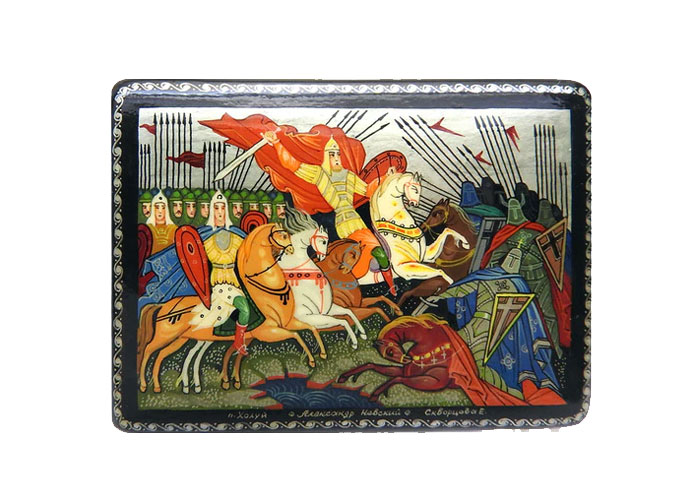Kholui and Mstera Lacquer Painting
Posted by Maison Russe on Feb 1st 2021
Kholui (aka Kholuy or even Holui) is an ancient settlement which straddles the Teza river in central Russia and is near Mstera and Palekh. In the 1600's it took 5-6 days to get to Kholui from Moscow. Today it takes 5-6 hours. Kholui is first mentioned in 1543 in a letter proclaiming that Ivan the Terrible had freed the considerable regional salt works from future taxes. 70 years later, the settlement is once again mentioned as a center for the production of painted icons. As part of a group of three famous villages where icons were painted (see above), iconography in Kholui apparently appeared first. Their icon painters were the monks of the Kholui Trinity Monastery which belonged to the much larger Trinity-Sergius Lavra. Icon painting developed rapidly due to an increased demand for icons. Many were produced and delivered to the northern provinces of Russia, including Vologda, Arkhangelsk, Petersburg, and to the Russian capital itself. Moreover, Kholui craftsmen received orders from other countries such as Bulgaria, Macedonia and Serbia.
Kholui Miniatures (Холуйская миниатюра) was founded in the 1930's for the production of boxes by a group of artists whose descendants were these aforementioned icon painters. Kholui miniatures are stylistically less bound by tradition than miniatures from Palekh or Mstera. A Kholui artist will paint on a completely black background, as the painters of Palekh prefer, or will paint on a colored background, similar to Mstera. The themes includes traditional fairy tales (think Snowmaiden or Ruslan and Ludmila), architectural scenes of local churches and monasteries, as well as floral bouquets. All in all, the traditions have survived. There is a vocational art school in Kholui, founded in 1943, which is being reorganized, soon to become a branch of the Higher School of Folk Arts of St. Petersburg. Here many new artists are taught and have graduated , and there are even artist dynasties, going back several generations. A lacquer miniature is a handmade piece of art, very laborious to make and difficult to understand. In today's crazy world, there is nothing more satisfying than to own, hold and appreciate a genuine Russian lacquer miniature.
Mstera, or Mstyora (Мстёра) miniatures are different from Palekh and Kholui miniatures, though, on first glance, they all can seem the same. Generally, Mstera painters chose a solid color background for their work, and seldom black, which is prefered in Palekh. The village of Mstera is located in the center of the Vladimir-Suzdal province on two rivers. The landscape of the village is reflected in the fields and foliage of many Mstera boxes. The first mention of Mstera goes back to 1609, whose artists excelled in embroidery, silver and copper metalwork and icons and frescoes. By the end of the 19th century, icon painting was first and foremost in Mstera (the name of the village derives from Masters). An artel of "Old Russian Painting" was organized in Mstera in 1923. However, since icons were no longer painted due to repression of the church by the government, the artists mastered painting on papier-mache boxes, which are more durable than wood. Genuine Mstera miniatures take a long time to make, as the work is piecemeal. The result is a work of art. Linseed oil, aka flaxseed oil, is used in the production of the boxes, which are lacquered and polished at least seven times. In 1932 the artel was transformed into the "Proletarian Art" factory. As of 2017, there were only about three dozen artists left in Mstera, indicating the serious threat of extinction for this traditional art.

